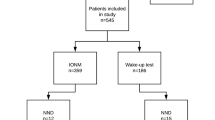Abstract
Background
Intraoperative neuromonitoring (IONM) is used to detect impending neurologic damage during complex spinal surgeries. Although IONM is increasingly used during pediatric scoliosis surgeries in the United States, the effect of IONM on the outcomes of such surgeries at a national level is unclear.
Methods
Using National Inpatient Sample (NIS) from 2009 to 2012, 32,305 spinal fusions performed in children 18 years old or younger of age with scoliosis were identified using ICD-9 procedure and diagnosis codes. IONM was identified using the ICD-9 procedure code 00.94. The effects of IONM use on length of stay (LOS), discharge disposition, hospital charges, and in-hospital complications were assessed using multivariate regression analysis adjusting for patient and hospital characteristics.
Results
IONM was used in 5,706 (18%) of the surgeries. IONM was associated with increased home discharge (adjusted odds ratio [AOR] = 1.25 [95% confidence interval 1.10-1.40], p = .001). There was no difference in LOS (p = .096) and hospital charges (p = .750). Neurologic complications were noted in 52 (0.9%) surgeries using IONM and 368 (1.4%) surgeries without IONM (p = .005). Although IONM use trended toward lower risk of neurologic complications in multivariate analysis, it failed to achieve statistical significance (AOR = 0.77 [0.57-1.04], p = .084).
Conclusions
Reported use of IONM in this database was significantly less compared with other databases, suggesting that IONM might be underreported in the NIS database. Nevertheless, in this database, IONM was significantly associated with increased home discharge. Hospital charges and LOS were not affected by IONM. There was a trend toward lower risk of neurologic complications with IONM use, though this finding was not statistically significant.
Similar content being viewed by others
References
Coe JD, Arlet V, Donaldson W, et al. Complications in spinal fusion for adolescent idiopathic scoliosis in the new millennium. A report of the Scoliosis Research Society Morbidity and Mortality Committee. Spine (Phila Pa 1976) 2006;31:345–9.
Devlin VJ, Schwartz DM. Intraoperative neurophysiologic monitoring during spinal surgery. J Am Acad Orthop Surg 2007;15:549–60.
Reames DL, Smith JS, Fu K-MG, et al. Complications in the surgical treatment of 19,360 cases of pediatric scoliosis: a review of the Scoliosis Research Society Morbidity and Mortality database. Spine (Phila Pa 1976) 2011;36:1484–91.
Thompson GH, Wilber RG, Shaffer JW, et al. Segmental spinal instrumentation in idiopathic scoliosis. A preliminary report. Spine (Phila Pa 1976) 1985;10:623–30.
Wilber RG, Thompson GH, Shaffer JW, et al. Postoperative neurological deficits in segmental spinal instrumentation. A study using spinal cord monitoring. J Bone Joint Surg Am 1984;66:1178–87.
Cole T, Veeravagu A, Zhang M, et al. Intraoperative neuromonitoring in single-level spinal procedures: a retrospective propensity score-matched analysis in a national longitudinal database. Spine (Phila Pa 1976) 2014;39:1950–9.
Fu K-MG, Smith JS, Polly DW, et al. Morbidity and mortality associated with spinal surgery in children: a review of the Scoliosis Research Society morbidity and mortality database. J Neurosurg Pediatr 2011;7:37–41.
Schwartz DM, Auerbach JD, Dormans JP, et al. Neurophysiological detection of impending spinal cord injury during scoliosis surgery. J Bone Joint Surg Am 2007;89:2440.
Sankar WN, Skaggs DL, Emans JB, et al. Neurologic risk in growing rod spine surgery in early onset scoliosis: is neuromonitoring necessary for all cases? Spine (Phila Pa 1976) 2009;34:1952–5.
Ney JP, van der Goes DN, Nuwer MR. Does intraoperative neurophysiologic monitoring matter in noncomplex spine surgeries? Neurology 2015;85:2151–8.
Gunnarsson T, Krassioukov AV, Sarjeant R, et al. Real-time continuous intraoperative electromyographic and somatosensory evoked potential recordings in spinal surgery: correlation of clinical and electrophysiologic findings in a prospective, consecutive series of 213 cases. Spine (Phila Pa 1976) 2004;29:677–84.
James WS, Rughani AI, Dumont TM. A socioeconomic analysis of intraoperative neurophysiological monitoring during spine surgery: national use, regional variation, and patient outcomes. Neurosurg Focus 2014;37:E10.
HCUP-Nationwide Inpatient Sample (NIS). Healthcare Cost and Utilization Project (HCUP). Rockville, MD: Agency for Healthcare Research and Quality; 2015. Available at: www.hcup-us.ahrq.gov/nisoverview.jsp. Accessed January 1, 2015.
Agency for Healthcare Research and Quality. HCUP Comorbidity software. Healthcare Cost and Utilization Project (HCUP) 2014. Available at: https://www.hcup-us.ahrq.gov/toolssoftware/comorbidity/comorbidity.jsp. Accessed September 15, 2017.
US Department of Labor. Bureau of Labor Statistics. Consumer Price Index 2017. Available at: http://www.bls.gov/data/inflation_calculator.htm. Accessed September 15, 2017.
R Core Team. R: a language and environment for statistical computing.
George J, Newman JM, Ramanathan D, et al. Administrative databases can yield false conclusions—an example of obesity in total joint arthroplasty. J Arthroplasty 2017;32(9 suppl):S86–90.
Lawson EH, Louie R, Zingmond DS, et al. A comparison of clinical registry versus administrative claims data for reporting of 30-day surgical complications. Ann Surg 2012;256:973–81.
Hamilton DK, Smith JS, Sansur CA, et al. Rates of new neurological deficit associated with spine surgery based on 108,419 procedures: a report of the Scoliosis Research Society morbidity and mortality committee. Spine (Phila Pa 1976) 2011;36:1218–28.
McGrory BJ, Klassen RA. Arthrodesis of the cervical spine for fractures and dislocations in children and adolescents. A long-term follow-up study. J Bone Joint Surg Am 1994;76:1606–16.
Molinari RW, Bridwell KH, Lenke LG, et al. Complications in the surgical treatment of pediatric high-grade, isthmic dy splastic spondylolisthesis. A comparison of three surgical approaches. Spine (Phila Pa 1976) 1999;24:1701–11.
Qiu Y, Wang S, Wang B, et al. Incidence and risk factors of neurological deficits of surgical correction for scoliosis: analysis of 1373 cases at one Chinese institution. Spine (Phila Pa 1976) 2008 ;33: 519–26.
Ajiboye RM, Zoller SD, D’Oro A, et al. Utility of intraoperative neuromonitoring for lumbar pedicle screw placement is questionable. Spine (Phila Pa 1976) 2017;42:1006–10.
Author information
Authors and Affiliations
Corresponding author
Additional information
Author disclosures: JG (none), SD (none), ACE (none), RCC (none), TEK (none), RCG (none).
The authors declare no conflicts of interest.
No funding was obtained for this study.
The study was exempt from IRB approval as it used a publicly available database.
Rights and permissions
About this article
Cite this article
George, J., Das, S., Egger, A.C. et al. Influence of Intraoperative Neuromonitoring on the Outcomes of Surgeries for Pediatric Scoliosis in the United States. Spine Deform 7, 27–32 (2019). https://doi.org/10.1016/j.jspd.2018.05.013
Received:
Revised:
Accepted:
Published:
Issue Date:
DOI: https://doi.org/10.1016/j.jspd.2018.05.013




